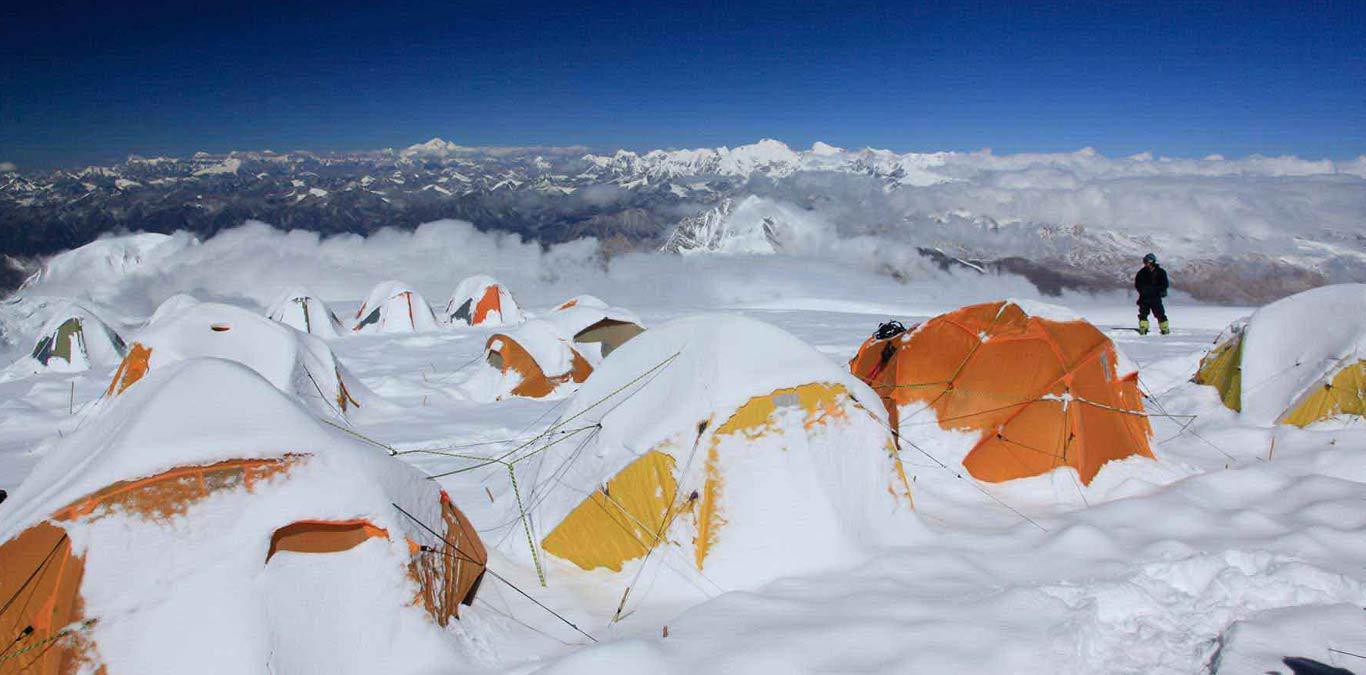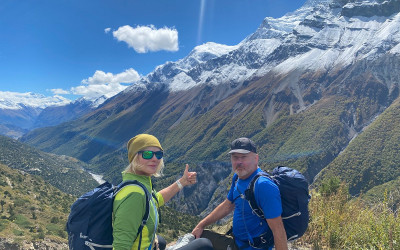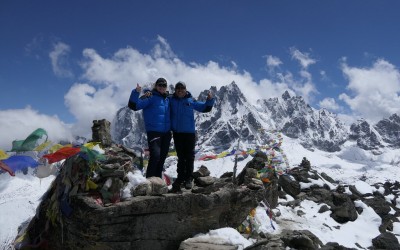Trip At Glance
-
Group Size2-15 Persons
-
Max Elevation8,201 Meters
-
GradeFull Fledge Mountaineering Climbing Classification
-
DestinationTibet
-
TransportationPrivate Jeep/Bus
-
AccommodationHotel/Guest house/Camping
-
CostContact Us
-
Trip Length38 days
-
Best MonthMarch to June & September/October
-
WIFIMost of the Places available
-
RegionExpedition
-
Trip ModeHotel/Camping
-
MealB/L/D
-
Trekking StyleDrive and Climb
overview
Trip Overview
‘adventure on top of world’s highest, largest tableland and a plateau of Tibet’
Mt. Cho-Oyu Expeditions where you will stand atop world’s sixth highest mountain that straddles the border between two countries the north within Tibet and the southern side in Nepal near Everest region at Gokyo. Mt. Cho-Oyu rise high above 8,201 m and 26,906 ft high within vast Tibetan plateau and the highest and largest on this planet, where the mountain lies close to Kyachun Khang and Everest near Nangpa-la pass which leads to Khumbu region from Tibet. Mt. Cho-Oyu Expeditions first started in early 19th October 1954 led by Austrian Mountaineers H.Tichy, S, Jöchler with Pasang Dawa Lama (Nepalese), since then decades of gaps when China annexed Tibet into its main land, but opened its doors for outside travelers and adventurer from 1970’s onward slowly becoming as one of the most popular 8,000 meter peak to climb its summit.
Mt. Cho-Oyu one of most accessible mountain to climb out of all eight thousand meters peaks due to its less technical difficulties than other high mountains of moderate challenge to reach its top which offers spectacular scenery of both Nepal and Tibet landscapes with close views of Mt. Everest and Mt. Shisapangma with series of other peaks that borders between Nepal and Tibet. Starting our marvelous adventure Mt. Cho-Oyu Expeditions with full preparation in Kathmandu where an exciting overland reaches high country of Langtang Himal areas and going through the frontier of Nepal and Tibet at Kyirong, once inside Tibetan soil on the northern side of Langtang and Ganesh Himal range where drive continues of wide terrain facing full views of snow capped mountain range to reach at Old Tingri, located on main Kathmandu & Lhasa Friendship Highway. At Old Tingri with acclimatization and rest to explore Tibetan village and town enriched with colorful custom and age-old culture of Buddhism religion with views of Mt. Everest and Cho-Oyu towards East, where our drive continues towards Cho-Oyu base camp for the adventure and climb to the summit of Mt. Cho-Oyu.
Tramping Himalaya Adventures provides ample time for the climb with maximum of twenty days just to reach its summit and back at base camp, during 20 days with rest, practice and checking health conditions of each climbing members and then heading for the Big Haul and climb on top Cho-Oyu using Advance with other high camps up to Camp III at above 7,300 m where the final bid is made. The climbing day to the summit determined at base camp depending upon favorable weather to reach the top where our expert guides will make the path more accessible fixing ropes and snow bar where necessary as safety measures. Once on top enjoy fantastic panorama of mountains and dramatic landscapes of both countries and then descend safely back to base camp using and packing up other camps then with final preparations for journey back to Kathmandu with mesmerizing adventure of a life time on Mt. Cho-Oyu Expeditions
Trip at a Glance
Trip Mode: Hotel – Lodge and Guest House with camping from base camp onward.
Trip Grade: Moderate to Adventurous (on drives)
People & Culture: Mostly Tibetans of Buddhism religion, with some Chinese.
Climbing Grade: Full Fledge Mountaineering Climbing Classification.
Expedition Region: Tibet Autonomous region of China on route Kyirong- Tingri to Cho-Oyu
Expeditions Durations: 33 Nights & 34 Days (In Tibet and Nepal border with drives both ways).
Total Expeditions: 39 Nights & 40 Days (Kathmandu to Kathmandu)
Seasons: April to June and September to October.
HIGHLIGHTS
Highlights of Mt. Cho Oyu Expedition
- Scenic and exciting journey to Tibet from Nepal with panorama of mountains with views of Everest
- Trekking into world highest and largest plateau within Tibet with overwhelming scenery
- Explore Tibetan traditional farm villages and monasteries of immense Buddhist cultures
- Adventure on top world 6th highest Mt. Cho-Oyu with sweeping panorama of Nepal and Tibet
- A classic adventure following Yak and Yeti trails towards base camp and beyond to Mt. Cho-Oyu
ITINERARY
Detailed Itinerary
Cost Included
- Airport Pick up & Drop with private transport
- Hotel in Kathmandu 5 Nights, 3-star standard with B/B ( Norbulinka Boutique Hotel or Similar )
- Kathmandu to Shyabrubensi-Rasuwa Gadhi ( Kerung Border Private Jeep )
- Tibet travel visa and permit ( Royalty: USD 9300/4000 for members/Staffs )
- Official Liason Officer for Mt. Cho-Oyu Expedition from Tibet
- Kerung-Tingri-Chinese BC and transportation on SUV minibus on sharing
- Full camping logistics set up in Chinese BC Intermediate Camp and Advance BC
- 3 meals a day ( B/L/D )Cookded by our expedition cook at Base Camp, and Advance Base Camp
- 1:1 Experienced Climbing Sherpa Guide and required Bas Camp Staffs in Sharing plan
- Solar panels for light and battery charging at Base Camp
- Gamow bag at Base Camp for emergency recuse purposes
- Carog and duties clearing assistance services in Kerung border both ways
- Necessary member tents for ABC ( 1:1) and high camps C-1, C-2, C-3
- 2 Ocygen ( 4 Ltrs, ) Bottles for Climbing members and 1 Oxygen for Sherpa
- Mask and regulator set for each climbing member and support Sherpa
- First aid medical kits for the group and the staff at Base Camp
- Baggage allowance carrying by Yak up and down to ABC from CBC-50 Kg each
- Walkie-talkies and Satellite phone for communications ( Uses charge per minute USD 5 )
- Combined pred-departure information for the members and staffs
- Office service charges and Government taxes levied in Nepal
Cost Excluded
- Nepalese visa fee ( Bring the right cash in USD and 2 passport-size photographs )
- 15 Days USD 30, 30 Days USD 50, 90 Days USD 125,
- Airfare International and domestic flights other than specified
- Lunch and dinner during your stay in Kathmandu Except for farewell dinner in Kathmandu
- Clothing, Packing items, Personal Medical Kit, Personal trekking/climbing gears
- Items of a personal nature like phone calls and like laundry and internet uses,
- Any extra services or products or offers or activities not mentioned in the Itinerary
- Any additional staff (s) especially required by the climbing member
- Rescue, repatriation, medicines, medical tests and hospitalization expenses
- Medical travel insurance and emergency rescue evacuation if required
- Any extra expenses arising out of various/unforeseen situations like natural calamities, landslides, political disturbances, Strikes, Changes in Government regulations, etc,
- Nepal custom duty fees for import or expedition goods if required
- Summit bonus to the personal climbing Sherpa ( Beginning from a minimum of USD 1000 per Summit per Sherpa)
- Tips for Base Camp Staffs per climbing member from a minimum of USD 200 in total for all the staff
- Any other item not mentioned in the service package exclude section,
Information
Some Additional Information
Fixed Departure
| SN | Start Date | Trip Duration | Cost Per Person | Availability | Join Group |
|---|---|---|---|---|---|
| 1 | 2024-09-01 | 38 Days | Available | Book Now |
















